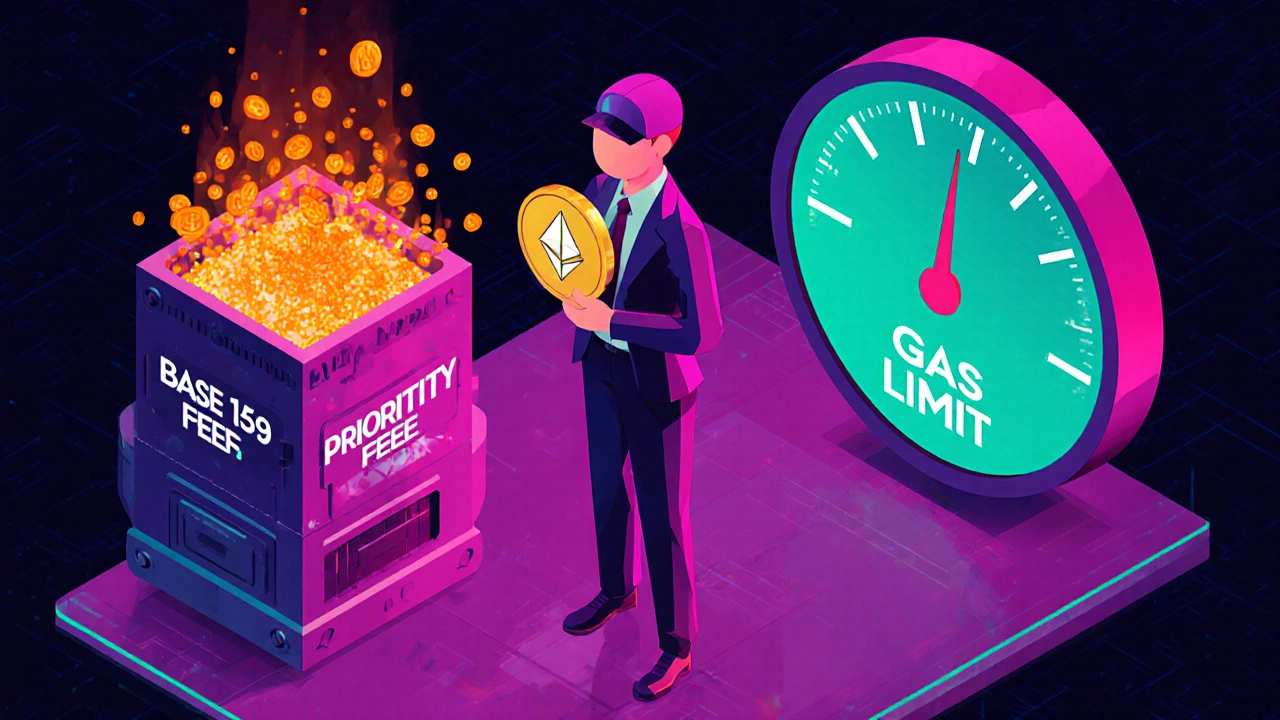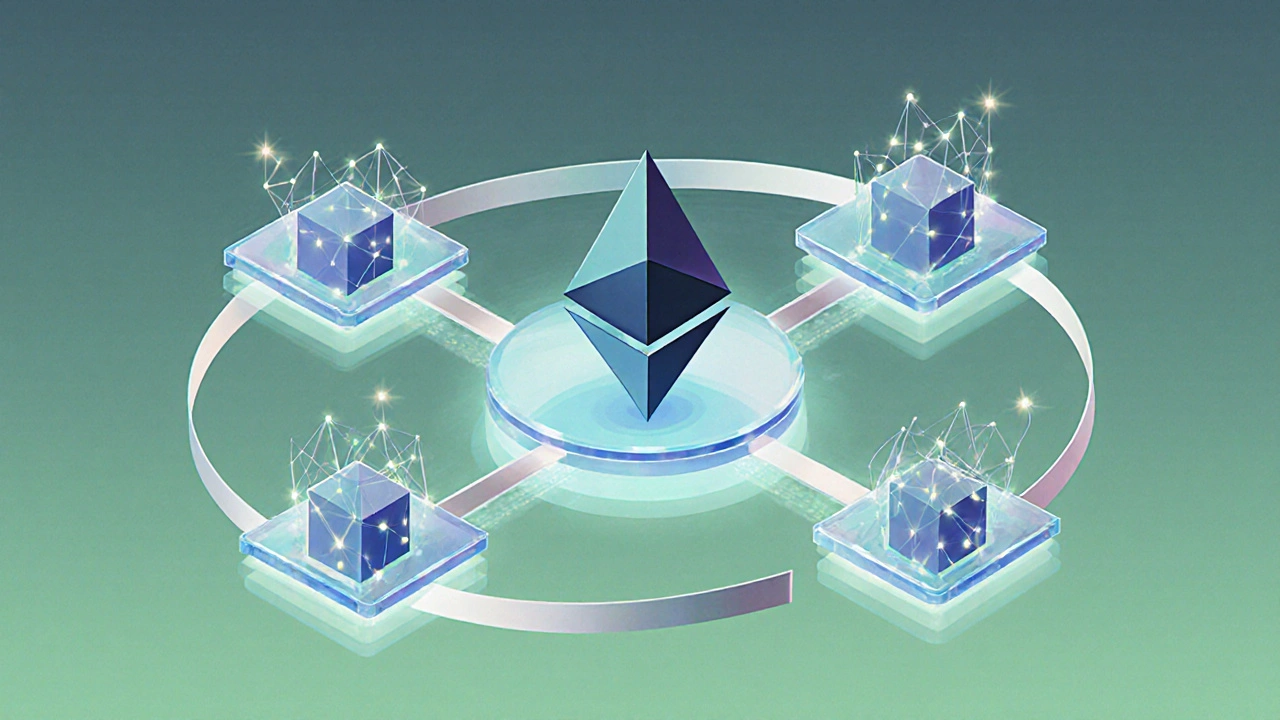When you send a transaction on Ethereum a decentralized, programmable blockchain platform, you’ll notice a tiny amount deducted from your wallet. That deduction is the Ethereum gas fee the payment that compensates miners or validators for doing the heavy lifting of processing your transaction. If you’ve ever wondered why you can’t just transfer Ether for free, this guide breaks down the why, how, and what‑if of gas fees in plain English.
Quick Takeaways
- Gas fees are paid in Ether (ETH) and cover computation, storage, and network priority.
- The fee = gas used × gas price (gwei). Gas used depends on transaction complexity.
- EIP‑1559 introduced a base fee that burns ETH and a priority fee that goes to validators.
- Tips to lower fees: choose off‑peak times, set appropriate gas limits, and use layer‑2 solutions.
- Future upgrades (Ethereum 2.0, sharding) aim to reduce fees dramatically.
Why Does Ethereum Need Gas?
The Ethereum network is a shared computer. Every time someone runs code-whether it’s a simple ETH transfer or a complex DeFi smart contract-the network consumes resources: CPU cycles, memory, and storage. Gas is the internal pricing unit that quantifies how much computation a transaction requires. Without a cost, anyone could flood the chain with useless transactions, jamming the network and making it unusable. Gas creates an economic incentive for validators the entities that secure the blockchain by confirming blocks to prioritize valuable work.
How Gas Fees Are Calculated
Two numbers determine the fee you actually pay:
- Gas limit - the maximum amount of gas you’re willing to spend. Simple ETH transfers need ~21,000 gas; a DeFi swap can require 150,000 - 300,000 gas.
- Gas price - the amount you’re ready to pay per unit of gas, expressed in gwei (1 gwei = 0.000000001 ETH). Before EIP‑1559, you set this manually. After EIP‑1559, you set a max fee per gas and a max priority fee per gas.
The total fee (in ETH) is:
fee = gas_used × gas_price (or base fee + priority fee)
Because the network only charges for the gas actually used, over‑estimating the limit won’t cost extra-any unused gas is refunded.

EIP‑1559 and the New Fee Model
In August 2021, Ethereum introduced EIP‑1559 a protocol upgrade that changed how transaction fees are structured. The key components are:
| Component | Purpose | Who Receives It? |
|---|---|---|
| Base fee | Burned (removed from supply) | None - it’s destroyed |
| Priority (tip) fee | Incentivizes validators to include your tx quickly | Validator/Block proposer |
| Max fee per gas | Upper bound you’re willing to pay (base + tip) | Used to calculate actual fee |
The base fee adjusts automatically each block based on network demand, making fee estimation more predictable. When demand spikes, the base fee rises; when demand drops, it falls.
Step‑by‑Step: Estimating Your Gas Fee
- Identify the transaction type (simple transfer, token swap, contract interaction).
- Check the current base fee on a block explorer (e.g., Etherscan).
- Decide on a priority fee you’re comfortable with (usually 1‑5 gwei for average speed).
- Calculate max fee per gas = base fee + priority fee.
- Set an appropriate gas limit (most wallets suggest a safe default).
- Multiply gas used (actual consumption) by the effective gas price (base + tip) to see the final cost.
Many wallets now do this math for you, but understanding the steps helps you avoid overpaying.
Tips to Reduce Your Gas Costs
- Time your transaction: Gas demand drops during weekends and early UTC hours.
- Use Layer‑2 solutions: Platforms like Arbitrum, Optimism, and zkSync batch transactions and charge pennies.
- Bundle multiple actions: Smart contracts that batch swaps or moves reduce total gas compared to separate calls.
- Set a realistic gas limit: Over‑estimating doesn’t increase cost, but under‑estimating can cause a failed transaction and waste the gas already spent.
- Watch the mempool: Websites such as EthGasStation show real‑time fee estimates.

Future of Gas Fees on Ethereum
Ethereum’s roadmap targets lower fees through two main avenues:
- Ethereum 2.0 (the consensus layer upgrade): Moves from proof‑of‑work to proof‑of‑stake, cutting energy costs and opening the door for more efficient fee models.
- Sharding: Splits the network into multiple “shards” that process transactions in parallel, dramatically increasing throughput and reducing competition for block space.
Until these upgrades fully roll out, users rely on Layer‑2 scaling and careful timing to keep fees manageable.
Common Mistakes and How to Avoid Them
Setting too low a priority fee: Your transaction may sit in the mempool for hours or be dropped entirely. Always check current tip suggestions.
Ignoring the gas limit warning: Some wallets warn you if the limit is too low for the intended contract call. Overriding that warning can cause a failed tx and loss of the gas already spent.
Sending transactions during peak events: NFTs drops, major DeFi launches, and popular token sales flood the network. If you’re not in a hurry, wait a few hours.
Putting It All Together
In short, gas fees are the price you pay for using Ethereum’s shared computer. They protect the network from spam, incentivize validators, and reflect the computational work you request. By understanding the components-base fee, priority fee, gas limit-you can estimate costs, choose the right moment to transact, and even leverage cheaper Layer‑2 options. As Ethereum continues to scale, those fees should shrink, making the ecosystem more accessible for everyday users.
What is the unit "gwei" and why is it used?
Gwei stands for giga‑wei, where 1 gwei = 10⁹ wei. Wei is the smallest unit of Ether (1 ETH = 10¹⁸ wei). Using gwei lets users express gas prices in a human‑readable range (usually 1‑200 gwei) instead of tiny fractions of Ether.
How does the base fee get destroyed?
When a transaction is included, the protocol automatically subtracts the base fee from the sender’s balance and sends it to an irrecoverable address, effectively reducing the total ETH supply. This “burn” mechanism helps counter inflation.
Can I set my own gas limit?
Yes. Most wallets suggest a safe default, but advanced users can manually adjust the limit. The network will only charge for the gas actually consumed, so setting a higher limit won’t increase cost-just ensure it’s not too low or the transaction will fail.
Why are gas fees higher on popular token launches?
A token launch often triggers a surge of users trying to buy or trade at the same time. This spikes demand for block space, pushing the base fee up. Users who attach higher priority fees get included first, creating a temporary fee spike.
Are Layer‑2 fees counted as Ethereum gas fees?
Layer‑2 solutions charge their own fees, usually denominated in the same Ether unit but far lower because the work is done off‑chain. When you move assets back to Ethereum, you’ll pay a regular Ethereum gas fee for that final bridge transaction.



Comments
So you finally decided to dive into Ethereum gas, huh? Remember, every gwei you pay is just the network’s way of saying “thanks for not spamming the chain.” If you time your moves right, you’ll pay less than your daily coffee-maybe even half of it. Keep calm, stay curious, and your wallet will thank you.
The concept of gas, in its essence, mirrors the ancient notion of a toll road, where each traveler contributes to the upkeep of the path; yet, unlike stone bridges, this toll is dynamically recalibrated, responding to demand, supply, and the collective ambition of a decentralized ecosystem. One might argue that the base fee, being burned, introduces a subtle deflationary pressure, subtly reshaping the monetary fabric of Ethereum. Moreover, the priority fee, akin to a tip for a diligent courier, incentivizes validators to prioritize your transaction over others. As the network evolves, these mechanisms-though seemingly arcane-converge toward a more efficient, user‑friendly paradigm. Thus, understanding gas is not merely a technical requirement, but a gateway to responsible participation.
Gas fees are just part of using any platform you get what you pay for. If you keep an eye on the mempool you can avoid blowing your budget. Don't be surprised if it spikes during big events.
Sure, you can blame big events, but the real problem is that the fee model still punishes everyday users.
When one first encounters the labyrinthine architecture of Ethereum’s gas economics, the mind is immediately assaulted by a cascade of interlocking concepts that, at first glance, appear insurmountable; nevertheless, beneath this veneer of complexity lies a symphony of purpose, each note resonating with the fundamental principles of scarcity, incentive, and security. The very notion of gas, borrowed from the physical world, serves as a metaphorical lubricant, ensuring that every computational step is accounted for, thereby preventing the malignant proliferation of frivolous transactions that would otherwise threaten the integrity of the decentralized ledger. In this grand design, the base fee operates as a self‑adjusting thermostat, calibrated by the relentless ebb and flow of network demand, rising like a tide during periods of fervent activity and receding during moments of tranquil throughput. Simultaneously, the priority fee-affectionately termed a “tip” by the community-provides a subtle yet potent mechanism for users to signal urgency, rewarding validators who expedite the inclusion of their transactions. One cannot overlook the elegant simplicity of the gas limit, a safeguard that caps the maximum computational appetite of a transaction, thereby protecting the sender from inadvertent overspending while granting developers the latitude to craft intricate smart contracts. Moreover, the post‑EIP‑1559 paradigm, with its bifurcated fee structure, introduces a deflationary element through the burning of the base fee, a feature that quietly diminishes the total ether supply over time, counterbalancing inflationary forces. This burning process, though seemingly esoteric, carries profound macro‑economic implications, gradually augmenting the value proposition of holding ether in the long run. As the ecosystem matures, layer‑2 solutions emerge as the virtuoso soloists that off‑load the bulk of transactional weight, delivering near‑instant settlement at a fraction of the cost, while preserving the security guarantees of the underlying chain. Nevertheless, the on‑chain experience remains indispensable for activities that demand the highest degree of trustlessness, such as finality proofs and cross‑chain bridges. It is within this intricate dance of on‑chain rigor and off‑chain agility that the true promise of Ethereum is realized. The roadmap toward Ethereum 2.0 and sharding further amplifies this narrative, promising to fragment the network into parallel conduits that will exponentially increase throughput, thereby diluting competition for block space and suppressing fee volatility. In the interim, pragmatic users can harness simple heuristics-transacting during off‑peak UTC windows, judiciously setting priority fees, and employing reputable gas trackers-to navigate the volatile fee landscape with confidence. Ultimately, mastering gas is less about memorizing numerical thresholds and more about cultivating an intuition for the network’s pulse, allowing one to act with precision and foresight. As we stand on the cusp of this transformative era, the collective responsibility to educate, experiment, and iterate becomes paramount, for only through informed participation can we sculpt an ecosystem that is both accessible and resilient.
Alright, let me break it down for the rest of us: the base fee is burnt-yes, literally destroyed-so you’re effectively reducing total supply, which is a good thing for value, but you can’t pretend it’s free. Also, the priority tip isn’t a “nice gesture”, it’s a market‑driven bid, so if you set it too low the transaction sits there forever. And for the love of code, don’t set the gas limit below the contract’s requirement; you’ll just waste the gas you already paid. Finally, layer‑2 isn’t a gimmick, it’s a necessity if you want sub‑dollar fees. That’s teh gist, hope it helps.
Gas fees are just the price of using a shared computer.
Isn’t it poetic that you pay to keep the digital world alive? I mean, every gwei feels like a tiny tribute to the invisible miners who whisper in the blockchain’s ear. If you’ve ever felt the sting of a high fee, just remember: the network is a living beast, and you’re feeding it.
The real reason fees spike is that the elites control the validators. They want us all scared into paying more. It’s simple, no hidden agenda.
Great rundown! If you’re just getting started, try checking a gas tracker before you hit send, and don’t be afraid to set a modest tip-you’ll still get your transaction in a reasonable time. Keep experimenting and you’ll find a sweet spot that works for you.
Quick tip: many modern wallets now auto‑adjust the priority fee based on current network conditions, so you can safely rely on the default settings unless you’re in a hurry. Also, consider using a layer‑2 bridge for frequent swaps; the cost difference is massive.
Just a heads‑up: when you see a gas price listed in “gwei”, remember it’s 0.000000001 ETH per unit. Multiply that by the gas used, and you’ll have the exact fee in ETH. Simple arithmetic saves you from overpaying.
From a national security perspective, the decentralization of Ethereum is a strategic asset; the ability to transact without centralized oversight fortifies our economic sovereignty. However, the volatility of gas fees can impede mass adoption, which is why scaling solutions must be prioritized.